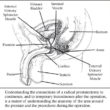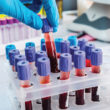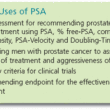Factors Associated with Time to Discontinuation of Active Surveillance for Prostate Cancer in a Multi-Institutional Cohort
The first descriptive article on Dr. Catalona’s, Witte’s, and Helfand’s SPORE project, “Factors Associated with Time to Conversion from Active Surveillance to Treatment for Prostate Cancer in a Multi-Institutional Cohort” has been accepted for publication in the Journal of Urology. The Editor, Dr. Joseph A. Smith, Jr. also has selected it for special promotion via a press release. The article will be published in the November issue of the Journal and online simultaneously with the final press release in 5-6 weeks. The second article on the SPORE project genome-wide association study has been submitted for publication and will be summarized in a future issue of Quest.

Previous studies have reported that Black men have more biologically aggressive PC, a higher risk of tumor Gleason grade reclassification or adverse surgical pathology after initial AS, and are more likely than White men to die of PC. Consequently, they have been reported to be managed with AS less frequently. Yet, some studies have reported similar risks for adverse outcomes on AS for Black and White patients with comparable tumor features.To avoid the side effects of overtreatment of potentially non-life-threatening prostate cancer (PC), the preferred management of patients with the lower-risk disease has evolved to active surveillance (AS). There are limited published data on the associations of demographic, clinical, and pathologic parameters with the time to converting from AS to treatment, and conflicting results have been reported on AS outcomes in diverse racial groups.
The outcomes of AS in Black men have been difficult to interpret because of small sample sizes and uncertainty as to the extent to which the reported differences were due to healthcare disparities. The largest studies reported to date comparing Black and White men on AS are from the Veterans Administration database. These studies reported that Black men on AS had an increased risk for disease progression, a greater likelihood to receive definitive treatment, and converted to treatment at an earlier time than White men.
Our multi-institutional cohort of 7,279 patients managed with AS had data and DNA samples collected for germline genetic analyses. Of 6,775 men included in the analysis, approximately one-third converted to active treatment with a median follow-up time of 6.7 years. The time to conversion was independently associated with their Gleason grade, serum PSA, clinical stage, and the number of cancerous biopsy cores at diagnosis. This study is the first to demonstrate that the risk for conversion for patients with high-volume Gleason grade group 1 tumor was higher than for low- and intermediate-risk patients and approached the patterns seen in patients with high-risk disease. Another important finding is that our exploratory analysis of the self-reported race bolstered by our using genetic ancestry markers of race measured from the patients’ DNA samples revealed no significant difference between Black and White men.
Our study is among the largest to assess the time to conversion from AS to treatment. Among its strengths is that it adds substantial quantification of how the parameters associated with the time to conversion from AS to treatment across a broad spectrum of risk groups, especially among high-risk and high-volume Gleason grade group 1 patients. Furthermore, we reduced the intrinsic limitations of studying self-reported race by including genetic ancestry.
Cooley, LF, et al. J Urol (in press)
©Sanford Radom, M.D.





















